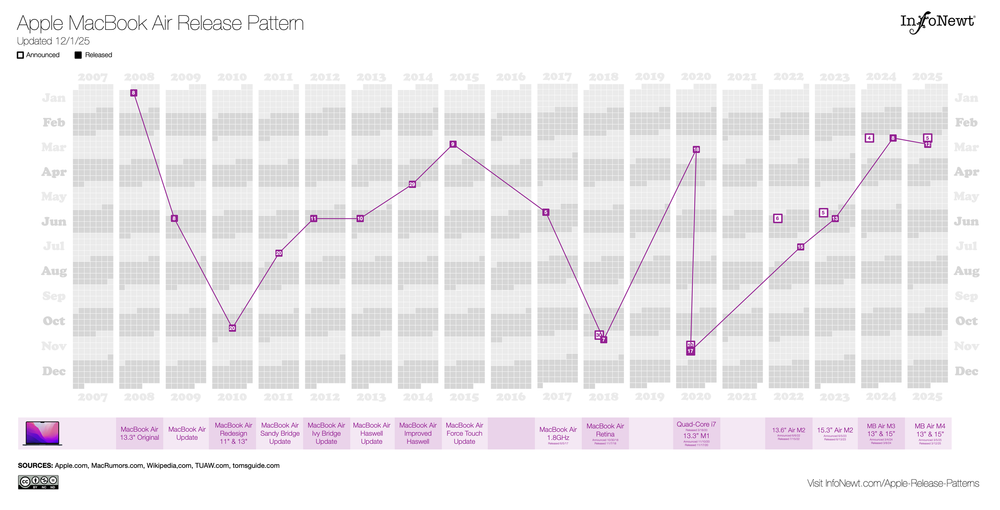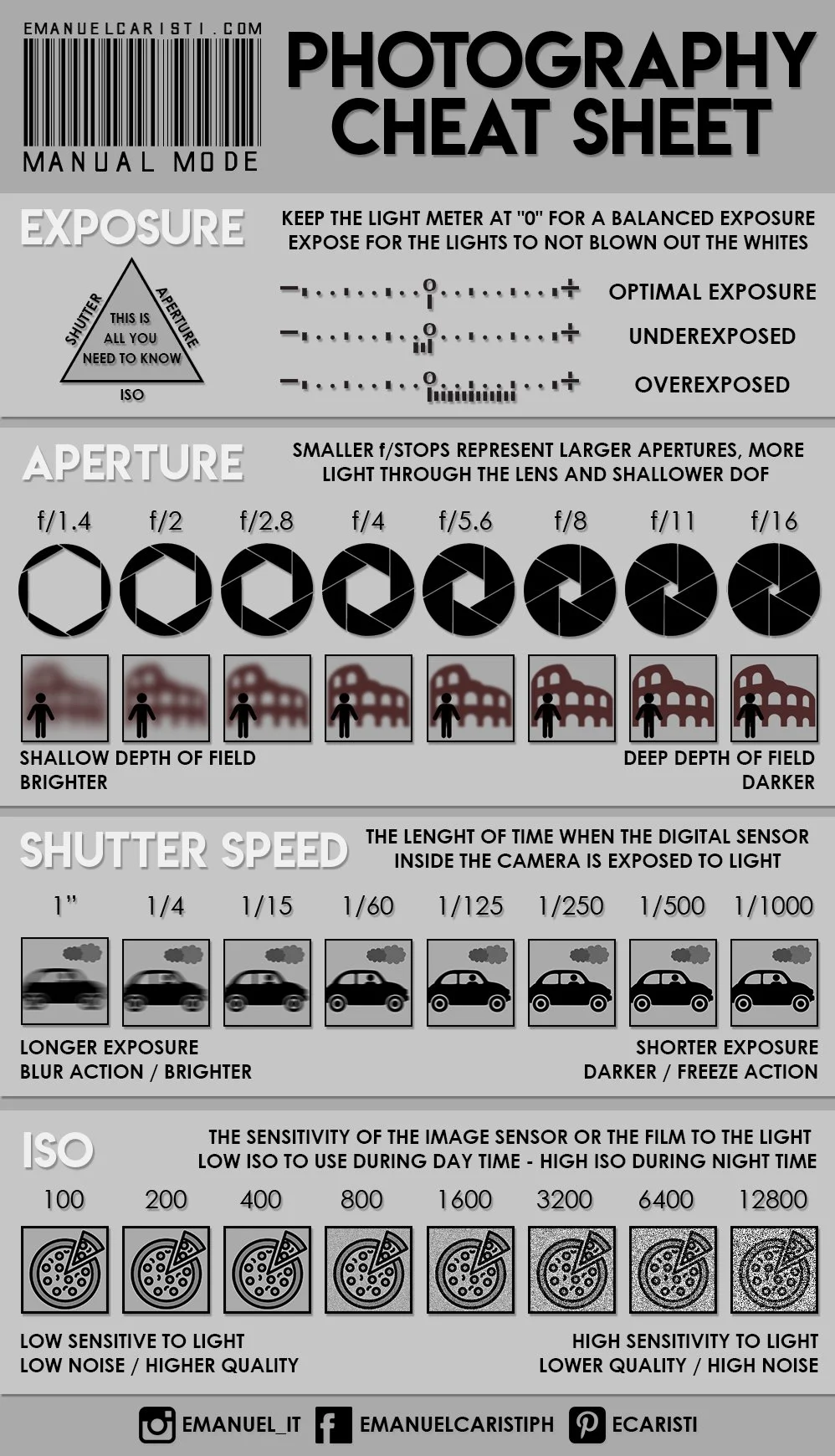2025-12-13 01:51:50
Apple traditionally doesn't release any products during December, so all of my Apple Release Patterns infographics are complete and up-to-date for 2025. You can see them all on the InfoNewt site, and that’s where I continue to maintain them and post updates as Apple releases new products and updates.
You can see that some products, like the iPhone, follow a fairly regular and predictable release schedule. Other products, like the MacBook Air, are much more unpredictable.

2025-10-30 09:55:53
Scorigami: Visualize Every NFL Score Ever is a fun interactive infographic were you can see every final NFL score in history and how often each score occurs. PerThirtySix took the inspiration from Jon Bois coined term “scorigami” and is updated weekly.
You can view all team or use the controls to narrow down the visualization to just the teams and years you want to see. It’s fun to play with.
A scorigami is a final score that has never happened before in the history of the NFL. The term was coined by Jon Bois and narrated in a 2017 video called Every NFL Score Ever (highly recommended, Jon Bois is one of best storytellers out there!). Since then, scorigami has entered the football lexicon and has become a fun way to track the history of the NFL.
Found on PerThirtySix
2025-10-15 02:42:28
The Planetary Society has a great collection of infographics and data visualizations about NASA and the U.S. Space Program.
Founded in 1980 by Carl Sagan, Louis Friedman, and Bruce Murray, The Planetary Society is the world’s largest and most influential non-profit space organization. With a global community of more than 2 million space enthusiasts, they promote their mission to “Empower the world’s citizens to advance space science and exploration.”

2025-10-07 03:12:59

For all of my fellow book authors, you can now positively determine if pirated copies of your book(s) were illegally used in the training of AI models. Use the search tool here: https://secure.anthropiccopyrightsettlement.com/lookup
Doing a quick check, I confirmed that the Cool Infographics book is included, as well as many of the other data visualization and infographics books that I have in my library. A quick check of many other popular dataviz authors confirms that pirated books by Alberto Cairo, Steve Wexler, Cole Nussbaumer Knaflic, Nathan Yau, Edward Tufte, Stephen Few, Garr Reynolds, Jonathan Schwabish, RJ Andrews, Manuel Lima, Andy Kirk, Noah Iliinsky, Scott Berinato, Ben Jones, Naomi Robbins, and David McCandless are all included in the training database.
The double-edged sword is that the inclusion of these books makes the AI models really good at giving advice about data visualizations, charts, and infographics. The models learned from the best. The downside is no compensation or credit is given to any of these authors who spent years of work building their knowledge and writing comprehensive books.
As part of the class action Anthropic Settlement from Bartz v. Anthropic in September 2025, an online searchable Works List of all books included in the lawsuit is now available. Authors can search the database to positively determine which of their book(s) were used to train the Anthropic models. Of course, not just dataviz books, but thousands of fiction and non-fiction books.
Historically, there hasn’t been an absolute list of pirated books used to train the major AI platforms. Allegedly, the BOOKS3 and LIBGEN databases online were lists of pirated books used by chatGPT, Meta and others to train their AI models. However, there was never any official confirmation by any of the AI companies about which specific pirated books they used.
This new development from the Anthropic settlement, is that they have made public a searchable database of the books covered under the lawsuit that were used in the training of their AI models. The lawsuit settlement forced them to be specific about which books were used. Although the search tool is convenient, it falls short of actually publishing the full list.
As an author, if you wish to be included in the settlement, you can file a claim on the settlement website: https://www.anthropiccopyrightsettlement.com
2025-09-16 04:04:28
Planets Mean Temperatures made by Jonathan Chris uses a box and whisker plot to show the average surface or atmosphere temperature of a planet in Celsius or Fahrenheit. A cool way to use the normal layout of the solar system graphic, but with the twist that they are rearranged by mean temperatures instead.
Explore the mean temperatures of planets. The mean temperature of planets refers to the average surface or atmospheric temperature of a planet over a specific period of time. This measure provides a general indication of the thermal environment of the planet and is typically calculated by averaging temperature readings taken at various locations and times on the planet’s surface or atmosphere.
I love this simple visualization, and the use of the actual planet images on the chart instead of dots and text.
Found on Tableau Public Viz of the Day
2025-08-22 00:21:51

Emanuel Caristi starts his photography tutorial on shooting in manual mode, with a Photography Cheat Sheet.
Shooting in manual mode is nothing mystical or for which you should be afraid, especially if you are not under pressure and you have time to meditate on your settings. Learning these simple technical knowledge will give you the photography fundaments, necessary to be confident with your camera and to taking control of the action.
All you need to know to start to take well-exposed pictures is how Aperture, Shutter speed, and ISO affect your photos.
I really simplified certain concepts to make them easier to digest, my wish is you get the basic tools to be more active taking photos. If you have not a DSLR or Mirrorless, you can certainly use your smartphone, its camera surely can be used in manual mode.
The visual example of each setting is incredibly helpful.
See full post at emanuelcaristi.com